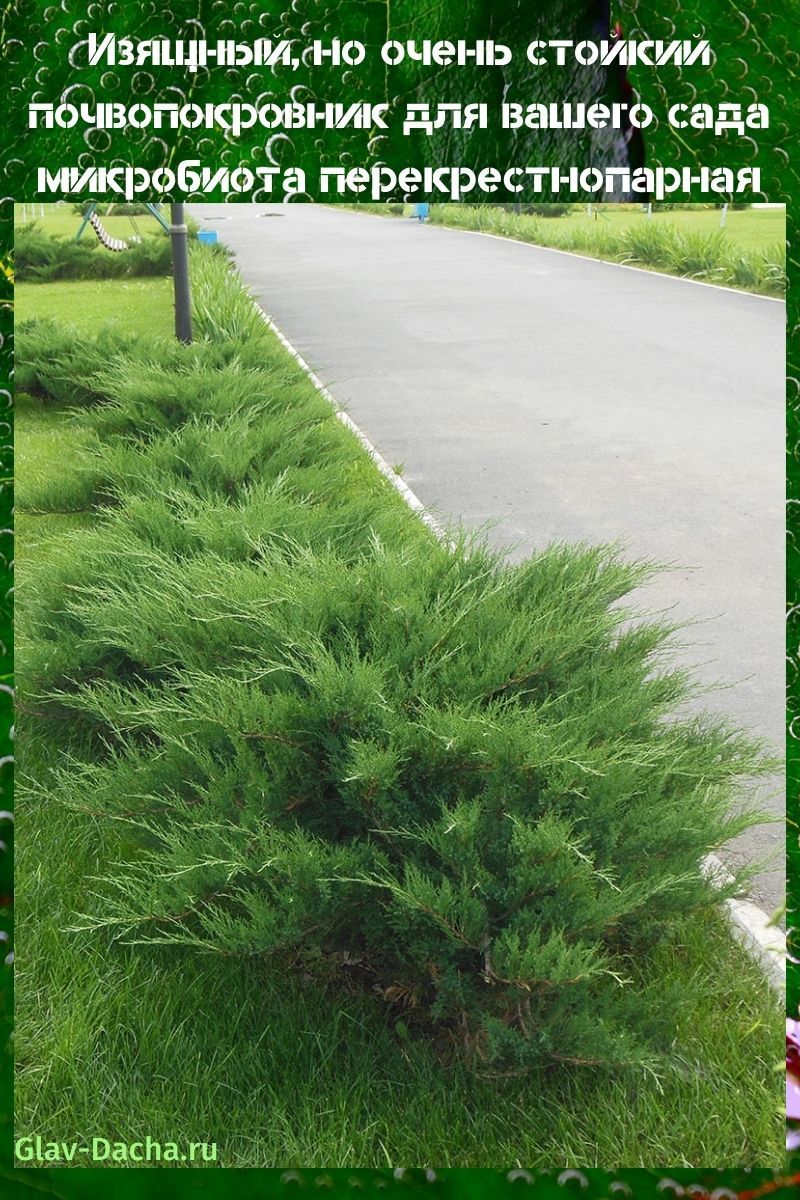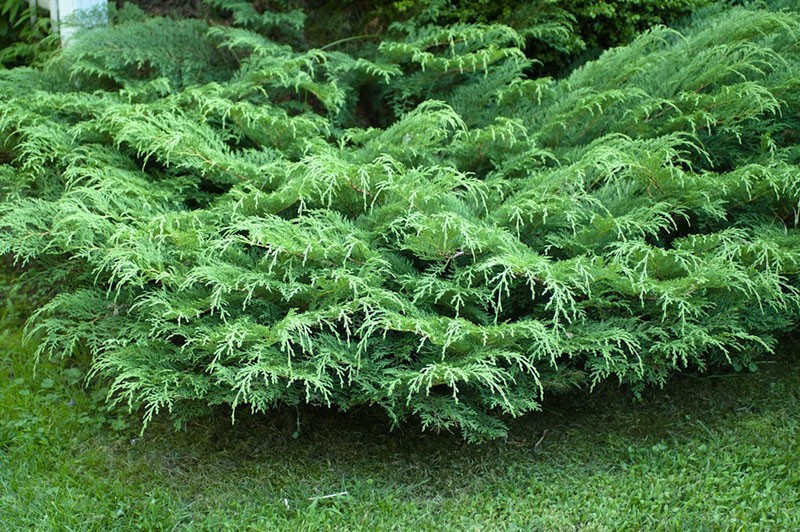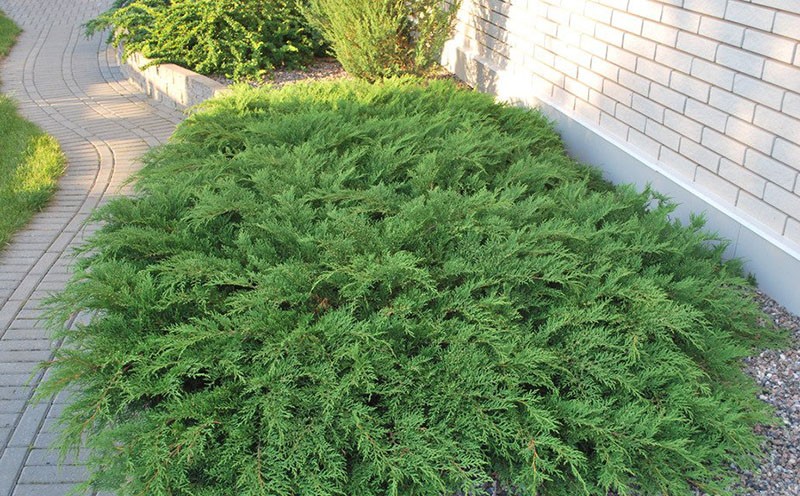A graceful yet highly resistant groundcover for your garden cross-pair microbiota
 Among coniferous crops, undersized species are especially popular, especially if they are unpretentious. This is exactly what the cross-pair microbiota is - a beautiful ground cover coniferous shrub. He looks impressive in group compositions, but he himself looks great on rocky slides. In spring and summer, the green needles of the microbiota will serve as a contrasting backdrop for bright and colorful flowers. And in the autumn-winter period, its dense spreading thickets themselves will become a decoration of the garden, standing out with brown needles that have changed color. High frost resistance and pliability of haircuts make it possible to grow ephedra in any region.
Among coniferous crops, undersized species are especially popular, especially if they are unpretentious. This is exactly what the cross-pair microbiota is - a beautiful ground cover coniferous shrub. He looks impressive in group compositions, but he himself looks great on rocky slides. In spring and summer, the green needles of the microbiota will serve as a contrasting backdrop for bright and colorful flowers. And in the autumn-winter period, its dense spreading thickets themselves will become a decoration of the garden, standing out with brown needles that have changed color. High frost resistance and pliability of haircuts make it possible to grow ephedra in any region.
Cross-pair microbiota - botanical characteristics

Despite its widespread use as an ornamental crop, the "wild" microbiota is classified as a rare plant. It is included in the Red Book of Russia and is protected by law as an endangered species.
What does a plant look like
 In terms of height, the coniferous shrub is quite compact in size and rarely exceeds 50 cm. But its shoots grow to the sides and reach 2 m in length, enrolling the microbiota to ground cover crops. Moreover, the branches are very flexible, but strong. They are absolutely "indifferent" to the severity of the snow cover or other load and do not break.
In terms of height, the coniferous shrub is quite compact in size and rarely exceeds 50 cm. But its shoots grow to the sides and reach 2 m in length, enrolling the microbiota to ground cover crops. Moreover, the branches are very flexible, but strong. They are absolutely "indifferent" to the severity of the snow cover or other load and do not break.
 The bush grows rather slowly, and in partial shade the growth rates are slightly accelerated. There, the annual growth is 15 cm, while the branches of bushes growing in the sun gain a maximum length of 10 cm. But this does not interfere with regulating growth and giving the microbiota any shape. She perfectly tolerates a haircut, which is important for owners of small areas. By regularly restraining growth, you can get a compact, lush bush instead of impenetrable thickets.
The bush grows rather slowly, and in partial shade the growth rates are slightly accelerated. There, the annual growth is 15 cm, while the branches of bushes growing in the sun gain a maximum length of 10 cm. But this does not interfere with regulating growth and giving the microbiota any shape. She perfectly tolerates a haircut, which is important for owners of small areas. By regularly restraining growth, you can get a compact, lush bush instead of impenetrable thickets.
The microbiota has another characteristic feature - seasonal color change. In the spring-summer period, its needles play with rich green tones. But with the onset of autumn, it darkens and becomes reddish-brown. Many gardeners immediately think that the bush is sick, however, with the first spring rays, the twigs turn green again.
Benefits of a ground cover
 Undoubtedly, microbiota can be called one of the best conifers for the garden.
Undoubtedly, microbiota can be called one of the best conifers for the garden.
Among her kindred cultures, she stands out favorably due to her such qualities.:
- It grows in any soil. Even on heavy loam, the bushes live for a long time, retaining their spectacular appearance, they just grow even more slowly.
- Feels good both in the shade and in the sun. Moreover, it is in shading that it develops faster. And it does not form bald spots, like many conifers.
- Easy to shape.This allows, with the help of a haircut, to restrain growth if necessary, not allowing the branches to grow in breadth.
- Possesses high frost resistance, which allows wintering without shelter. In nature, ephedra grows on the slopes of the mountains, blown by cold winds. The air temperature there reaches minus 40 ° C, so this ground cover is used to frost.
Microbiota belongs to monoecious plants. On the same bush are both female and male organs. Cones begin to appear visually already in the fifth year after planting, in early autumn.
They are small, only 6 mm long, rounded in shape, colored brown. They are located horizontally to the shoots.
Microbiota in landscape design, photo
Its decorative appearance, unpretentiousness and the possibility of formation make the ephedra an almost universal culture. Wherever you put it, everywhere bush will become the main decoration or serve as a spectacular contrasting object.
For example, you can plant a cross-pair microbiota:
- In the rock garden. Rocky terrain is its natural habitat. And it is precisely among the boring gray rocks and stones that the smart green microbiota looks the most advantageous.

- On the slope of the site, which the culture gracefully decorates with its sprawling crown. And the intertwining roots of the overgrown microbiota will strengthen the soil.
- In any, even shady, place in order to create a living carpet. Microbiota is the best at this task. Long branches, intertwining with each other near neighboring bushes, completely cover the soil and leave no chance for weeds. Moreover, even under trees, where most plants simply do not survive.

- On the lawn along the edge of paths and paths to create a beautiful curb. Regular haircuts will help contain growth, prevent overgrowth and maintain a compact shape.

- IN mixborders with flowering plants as a contrasting background. Green needles will favorably emphasize any color and plant, be it delicate pink lilies or blue cornflowers and simple cereals.

- On retaining walls, where the spreading branches of the plants will cover unsightly building materials. And over time, they will decorate the structure, hide its artificiality, making it a natural part of the landscape.

Cross-pair microbiota - planting and care
It is easy to grow ephedra and there will be no special problems with it. The ground cover is able to grow on almost any soil, anywhere and does not depend on weather conditions.
 The fastest way to get a lush bush in a short period of time is to purchase a seedling with a closed root system. It is advisable to plant it in the spring, then before the onset of cold weather the bush will have time to take root well and get stronger.
The fastest way to get a lush bush in a short period of time is to purchase a seedling with a closed root system. It is advisable to plant it in the spring, then before the onset of cold weather the bush will have time to take root well and get stronger.
Cross-pair microbiota in adulthood does not tolerate transplantation. Therefore, immediately select a permanent place for it.
But if, for some reason, it suddenly became necessary to change the "registration" of the ephedra, do it in early spring. After budding, such plants may not take root at all.
The ability of the soil cover to grow in the sun and in a shady place gives you a wide choice regarding its location. It all depends only on your desire and the availability of free space. However, do not forget that, despite the low height, the microbiota grows strongly to the sides. You will have to either immediately set aside a decent area for the shrub, or all the time restrain its development by pruning.
As for the soil, the only requirement of the coniferous representative is the absence of stagnant moisture. The drought-resistant microbiota does not tolerate waterlogging and begins to hurt. It will give the most active growth on loose sandy loam or on loam. Ephedra will be able to grow in heavy soil, but it will develop much more slowly.
How to care for your microbiota
 In the wild, sprawling coniferous thickets grow on their own, without any participation and help and despite the harsh conditions. Not surprisingly, home microbiota also expect next to nothing from you.
In the wild, sprawling coniferous thickets grow on their own, without any participation and help and despite the harsh conditions. Not surprisingly, home microbiota also expect next to nothing from you.
Caring for chic shrubs is the simplest and easiest:
- Feed young bushes in early spring, as soon as the snow melts, with mineral fertilizers for conifers. It is better to use complex preparations. But adult specimens can safely do without feeding.
- In dry summer, water the plantings occasionally so that they do not lose the rich color of the needles. In the presence of natural precipitation, plants do not need watering.
- Prune to maintain shape or contain growth. In this case, a haircut can be done at any time, both in spring or summer, and in autumn. Ephedra reacts painlessly even to the removal of large branches.
Due to the high frost resistance, the microbiota does not need shelter for the winter. It is possible to spud and cover with spruce branches only the young bushes planted in the current season.
How to propagate microbiota
 Microbiota multiplies at home mainly vegetatively, by cuttings or layering. Rooting cuttings can be done in spring or summer. In early spring, the cutting of the layer is also carried out - the lower branch. When it grows its own roots, separate and transplant. If you wish, you can also propagate microbiota and seeds, but this method is very troublesome. Seeds lose their germination already in the second year, they sprout slowly, and seedlings develop for a long time. But the seedlings tolerate transplanting well, unlike adult plants.
Microbiota multiplies at home mainly vegetatively, by cuttings or layering. Rooting cuttings can be done in spring or summer. In early spring, the cutting of the layer is also carried out - the lower branch. When it grows its own roots, separate and transplant. If you wish, you can also propagate microbiota and seeds, but this method is very troublesome. Seeds lose their germination already in the second year, they sprout slowly, and seedlings develop for a long time. But the seedlings tolerate transplanting well, unlike adult plants.
 Thus, if you need an unpretentious ground cover plant that is not afraid of frost, choose a cross-pair microbiota. Even if you do not have time to tinker in the garden or on the site at all, this ephedra can grow perfectly on its own. Slowly but surely, its shoots will lengthen every year until the landing site turns into a corner of wildlife. But the advantage of the ground cover is not even that. With regular trimming, you can keep your bushes tidy and compact.
Thus, if you need an unpretentious ground cover plant that is not afraid of frost, choose a cross-pair microbiota. Even if you do not have time to tinker in the garden or on the site at all, this ephedra can grow perfectly on its own. Slowly but surely, its shoots will lengthen every year until the landing site turns into a corner of wildlife. But the advantage of the ground cover is not even that. With regular trimming, you can keep your bushes tidy and compact.
Cross-pair microbiota for your garden - video
https://www.youtube.com/watch?v=zi8nI-souMA